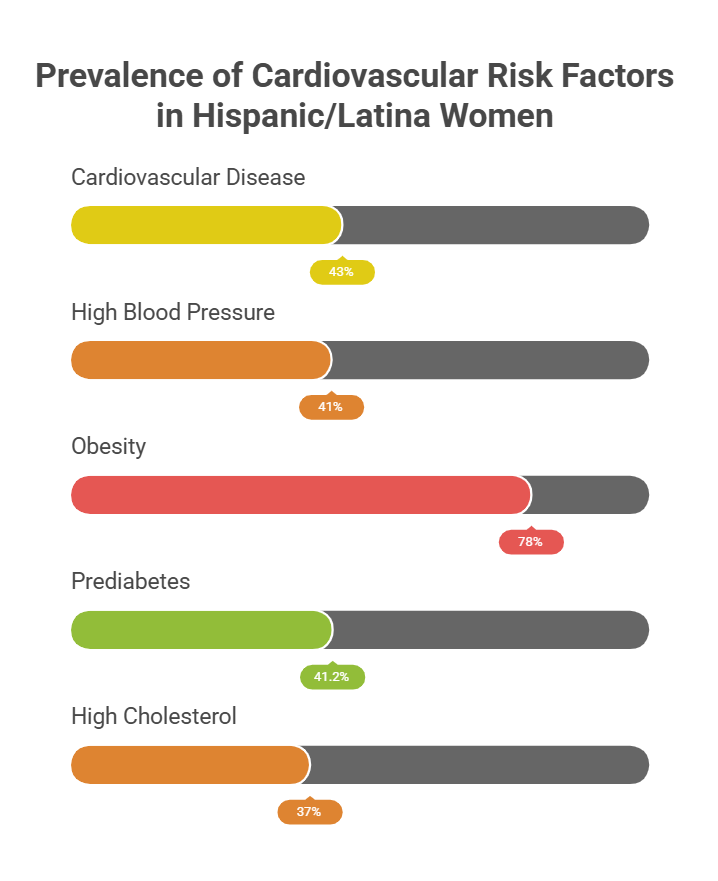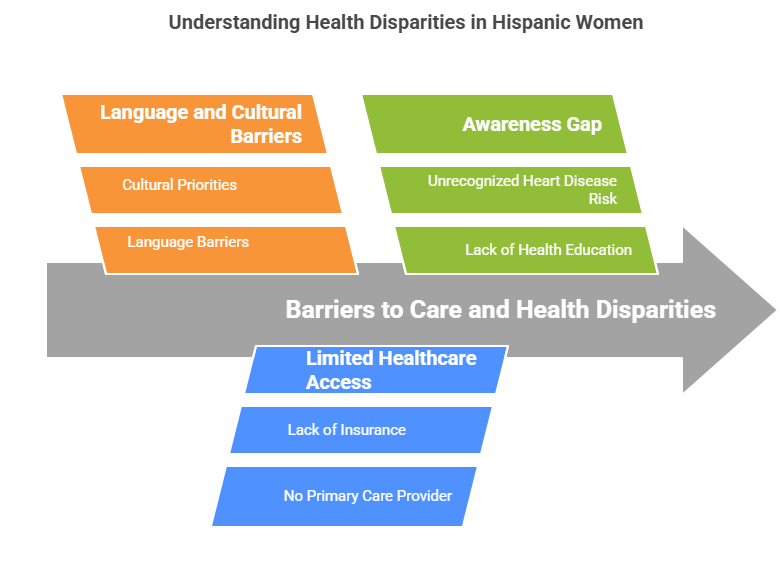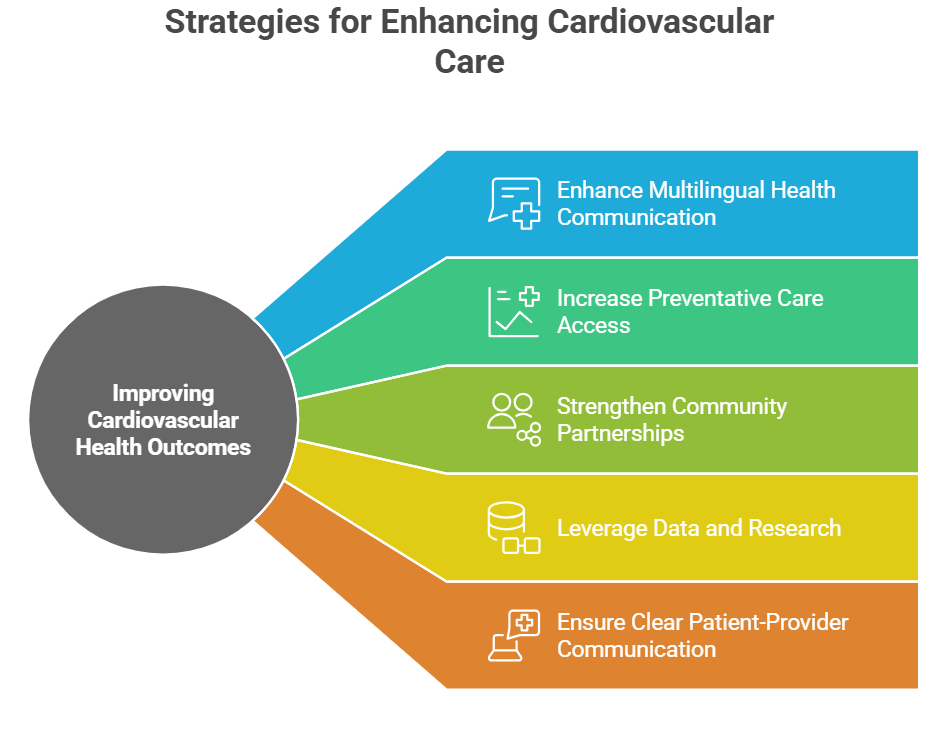Did you know that nearly 43% of Hispanic women live with cardiovascular disease, yet many don’t realize their risk until it’s too late? Cardiovascular disease (CVD) remains a primary cause of death among women, resulting in 28.3% of Hispanic female deaths. Healthcare organizations and insurance providers must address this issue to connect with multicultural audiences and improve health outcomes. Culturally informed health initiatives can help bridge the gap, ensuring that Hispanic women receive the care, education, and support they need to take charge of their heart health.
Heart disease affects millions of Hispanic women, yet awareness remains low. Understanding the key risk factors and prevalence of cardiovascular disease in this community is the first step in addressing the problem. Here’s what the data reveals:
- Prevalence: Nearly 43% of Hispanic/Latina women have some form of cardiovascular disease.
- High Blood Pressure: Almost 41% of Hispanic women have high blood pressure, a major risk factor for heart disease.
- Obesity and Diabetes: 78% of Hispanic women are overweight or obese, and about 13% have physician-diagnosed diabetes, with an additional 41.2% experiencing prediabetes.
- Cholesterol: Over 37% of Hispanic females have high total cholesterol levels (200 mg/dL or higher).

Despite advances in medical research and treatment, many Hispanic women still face significant obstacles when it comes to heart health. Cultural expectations, language barriers, and systemic inequities often prevent them from accessing preventative care and early treatment – leaving many unaware of their personal risk. Understanding these barriers is essential, as they directly impact early diagnosis, access to care, and long-term health outcomes.

Below are some of the key factors that contribute to these health disparities.
- Language and Cultural Barriers: Many face difficulties navigating the healthcare system due to language barriers and cultural perceptions that prioritize family over personal healthcare.
- Awareness Gap: Only 1 in 3 Hispanic women recognize heart disease as the leading cause of death among women in the U.S.
- Limited Healthcare Access: Hispanic women are nearly three times more likely than non-Hispanic white women to lack health insurance and often do not have a primary care provider.
How healthcare providers can bridge the gap
So, how can healthcare providers and insurers make a meaningful difference? A one-size-fits-all approach won’t work. Instead, organizations must prioritize culturally adapted communication, education, and community-driven initiatives to foster trust and engagement.
Enhance Multilingual Health Communication: Many Hispanic women feel more comfortable receiving health information in Spanish. Offering materials in their native language isn’t just about translation — it’s about cultural adaptation. Educational content should reflect real-life experiences, values, and concerns that resonate with Hispanic communities. This is where cultural intelligence plays a key role — helping healthcare organizations navigate cultural nuances to create meaningful, effective communication. Learn more about cultural adaptation in healthcare translations.
Increase Preventative Care Access:
- Preventative care can save lives, but it must be accessible and culturally relevant. Healthcare organizations can:
- Provide culturally relevant educational campaigns that highlight the importance of regular screenings and healthy lifestyle changes.
- Implement community-driven wellness programs that connect women with local resources and support groups.
- Promote screenings tailored to Hispanic communities, making them affordable and easy to access.
Strengthen Community Partnerships: Collaborate with local organizations to increase awareness and participation in heart health initiatives.
Leverage Data and Research: Data-driven strategies ensure that outreach efforts are effective. By utilizing insights from the American Heart Association, CDC, and community health reports, providers can develop evidence-based programs that address the specific needs of Hispanic women.
Ensure Clear Patient-Provider Communication: Language should never be a barrier to quality healthcare. Miscommunication can lead to misdiagnoses, poor treatment adherence, and worse health outcomes. Professional interpreters and culturally competent healthcare providers can make a world of difference in ensuring that Hispanic women receive the care they need.
Explore our healthcare interpreting solutions to bridge language gaps and improve patient outcomes.
If you’re a healthcare provider, insurer, or community organization looking to enhance your engagement with multicultural populations, investing in culturally tailored health initiatives can make a significant impact. Culturally tailored interventions have been shown to increase adherence to treatment plans, improve health behaviors, and enhance patient satisfaction. For example, tailored diabetes management programs that consider dietary preferences and cultural norms have demonstrated higher effectiveness compared to generic approaches. Research shows that culturally tailored health initiatives not only improve individual health outcomes but also strengthen overall community well-being. Now is the time to prioritize solutions that resonate with Hispanic women and empower them to take charge of their heart health.
Learn how CQ fluency helps healthcare organizations connect with diverse communities.
Want to improve health outcomes for Hispanic communities? Discover how our culturally adapted translations can help.

Read about heart disease and the risk for women on www.GoRedForWomen.org
For more information on creating culturally relevant medical documents from your organization please contact one of our team members today.
